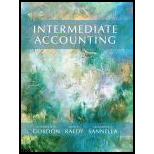
Concept explainers
LIFO, Conversion to FIFO. Inventory transactions tor Jack Franklin stores are summarized in the following table. The company uses the LIFO perpetual method for both financial and tax reporting.
| Transaction | Units | Sales in Units | Unit Cost | Total Cost |
| Beginning inventory: January 1 | ||||
| Oldest cost | 2,000 | $5 | $ 10,000 | |
| N9xt oldest cost | 1,750 | 8 | 14,000 | |
| Total beginning inventory | 3,750 | $ 24,000 | ||
| Purchases | ||||
| January 20 | 5,000 | 9 | 45,000 | |
| February 18 | 12,000 | 11 | 137,500 | |
| Subtotal | 21,250 | $206,500 | ||
| Units sold on May 1 at $18 | 19,000 | |||
| July 28 | 18,750 | 10 | 187,500 | |
| Total available for sale | 40,000 | $394,000 | ||
| Total units sold | (19,000) | |||
| Ending inventory | 21,000 |
The inventory footnote from Jack Franklin Stores annual report indicates that the difference between the LIFO costs and the current (FIFO) costs of inventory is equal to $0 and $12,750 at the beginning and end of the year respectively.
Required
- a. Determine the ending inventory and cost of goods sold for the current year.
- b. Use the footnote information provided in the question to convert the beginning and ending inventories from a LIFO to a FIFO basis.
- c. Convert the cost of goods sold for the current year from the LIFO to the FIFO basis.
- d. Compare the inventory turnover ratio for the current year computed under the two methods of
inventory valuation .
Learn your wayIncludes step-by-step video

Chapter 10 Solutions
Intermediate Accounting
Additional Business Textbook Solutions
Managerial Accounting (5th Edition)
Corporate Finance (4th Edition) (Pearson Series in Finance) - Standalone book
Financial Accounting: Tools for Business Decision Making, 8th Edition
Fundamentals of Management (10th Edition)
Principles of Economics (MindTap Course List)
Gitman: Principl Manageri Finance_15 (15th Edition) (What's New in Finance)
- 7. If inventory is overstated at year-end, which of the following is true?A. Net income is understatedB. Expenses are overstatedC. Net income is overstatedD. Assets are understated i need help in this question quiarrow_forwardI need correct answer 7. If inventory is overstated at year-end, which of the following is true?A. Net income is understatedB. Expenses are overstatedC. Net income is overstatedD. Assets are understatedarrow_forwardNo chatgpt 7. If inventory is overstated at year-end, which of the following is true?A. Net income is understatedB. Expenses are overstatedC. Net income is overstatedD. Assets are understatedarrow_forward
- 7. If inventory is overstated at year-end, which of the following is true?A. Net income is understatedB. Expenses are overstatedC. Net income is overstatedD. Assets are understatedneed anarrow_forwardNo ai 7. If inventory is overstated at year-end, which of the following is true?A. Net income is understatedB. Expenses are overstatedC. Net income is overstatedD. Assets are understatedarrow_forward7. If inventory is overstated at year-end, which of the following is true?A. Net income is understatedB. Expenses are overstatedC. Net income is overstatedD. Assets are understatedarrow_forward
- I mistakenly submitted blurr image please comment i will write values. please dont Solve with incorrect values otherwise unhelpful.arrow_forwardDevelopment costs in preparing the mine $ 3,400,000 Mining equipment 159,600 Construction of various structures on site 77,900 After the minerals are removed from the mine, the equipment will be sold for an estimated residual value of $12,000. The structures will be torn down. Geologists estimate that 820,000 tons of ore can be extracted from the mine. After the ore is removed, the land will revert back to the state of New Mexico. The contract with the state requires Hecala to restore the land to its original condition after mining operations are completed in approximately four years. Management has provided the following possible outflows for the restoration costs: Cash Outflow Probability $ 620,000 40% 720,000 30% 820,000 30% Hecala’s credit-adjusted risk-free interest rate is 7%. During 2024, Hecala extracted 122,000 tons of ore from the mine. The company’s fiscal year ends on December 31. Required: Determine the amount at which Hecala will record the mine. Calculate the…arrow_forwardI mistakenly submitted blurr image please comment i will write values. please dont Solve with incorrect values otherwise unhelpful.arrow_forward
- what are the Five List of Michael Porter's 5 Force Framework that describes the competitive dynamics of a firm and the industry they are in?arrow_forwardHello tutor i need help I mistakenly submitted blurr image please comment i will write values. please dont Solve with incorrect values otherwise unhelpful.arrow_forwarddefine each item below: A competitive advantage. 2) Data incorporation. 3) Financial Statement Analysis. 4) Product Differentiation. 5) Strategic positioning for a business firmarrow_forward
 Cornerstones of Financial AccountingAccountingISBN:9781337690881Author:Jay Rich, Jeff JonesPublisher:Cengage Learning
Cornerstones of Financial AccountingAccountingISBN:9781337690881Author:Jay Rich, Jeff JonesPublisher:Cengage Learning Financial Accounting: The Impact on Decision Make...AccountingISBN:9781305654174Author:Gary A. Porter, Curtis L. NortonPublisher:Cengage LearningPrinciples of Accounting Volume 1AccountingISBN:9781947172685Author:OpenStaxPublisher:OpenStax College
Financial Accounting: The Impact on Decision Make...AccountingISBN:9781305654174Author:Gary A. Porter, Curtis L. NortonPublisher:Cengage LearningPrinciples of Accounting Volume 1AccountingISBN:9781947172685Author:OpenStaxPublisher:OpenStax College Intermediate Accounting: Reporting And AnalysisAccountingISBN:9781337788281Author:James M. Wahlen, Jefferson P. Jones, Donald PagachPublisher:Cengage Learning
Intermediate Accounting: Reporting And AnalysisAccountingISBN:9781337788281Author:James M. Wahlen, Jefferson P. Jones, Donald PagachPublisher:Cengage Learning Financial And Managerial AccountingAccountingISBN:9781337902663Author:WARREN, Carl S.Publisher:Cengage Learning,
Financial And Managerial AccountingAccountingISBN:9781337902663Author:WARREN, Carl S.Publisher:Cengage Learning,





